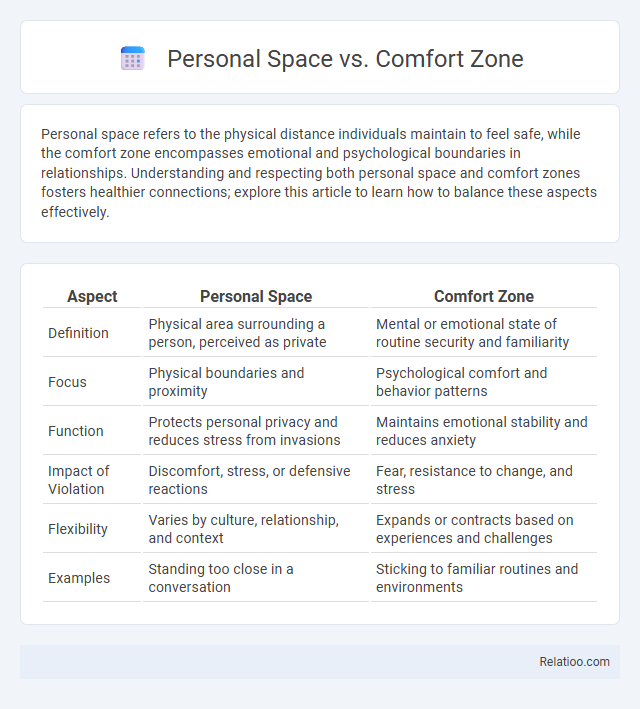Personal space refers to the physical distance individuals maintain to feel safe, while the comfort zone encompasses emotional and psychological boundaries in relationships. Understanding and respecting both personal space and comfort zones fosters healthier connections; explore this article to learn how to balance these aspects effectively.
Table of Comparison
| Aspect | Personal Space | Comfort Zone |
|---|---|---|
| Definition | Physical area surrounding a person, perceived as private | Mental or emotional state of routine security and familiarity |
| Focus | Physical boundaries and proximity | Psychological comfort and behavior patterns |
| Function | Protects personal privacy and reduces stress from invasions | Maintains emotional stability and reduces anxiety |
| Impact of Violation | Discomfort, stress, or defensive reactions | Fear, resistance to change, and stress |
| Flexibility | Varies by culture, relationship, and context | Expands or contracts based on experiences and challenges |
| Examples | Standing too close in a conversation | Sticking to familiar routines and environments |
Defining Personal Space and Comfort Zone
Personal space refers to the physical distance individuals maintain to feel safe and unthreatened, typically varying by culture and personal preference from 18 inches to 4 feet. Comfort zone encompasses the psychological state where a person feels at ease, free from stress or risk, allowing predictable behavior and familiar experiences. Understanding the difference helps distinguish between tangible spatial boundaries and mental or emotional limits shaping behavior and interaction dynamics.
Key Differences Between Personal Space and Comfort Zone
Personal space refers to the physical distance you maintain from others to feel secure and unthreatened, while your comfort zone encompasses a broader psychological state where you feel safe and in control emotionally and mentally. Personal space is mostly about immediate, physical boundaries and varies culturally and situationally, whereas the comfort zone involves familiar routines and experiences that reduce anxiety and stress. Understanding these key differences helps you navigate social interactions and personal growth by distinguishing physical boundaries from emotional limits.
The Psychology Behind Boundaries
Personal space, comfort zones, and psychological boundaries intertwine as crucial elements in understanding human behavior and emotional safety. Personal space refers to the physical distance individuals maintain to feel secure, while comfort zones encompass emotional and psychological boundaries where people feel in control and free from stress. These boundaries protect mental well-being by regulating social interaction and reducing anxiety, highlighting the brain's role in managing stress responses and maintaining a sense of stability.
Cultural Influences on Personal Space and Comfort Zone
Cultural influences significantly shape your perception of personal space and comfort zones, with variations in acceptable physical distance ranging from intimate to broader spatial boundaries across societies. In cultures like Japan, close proximity is often avoided to preserve harmony, whereas Latin American cultures may embrace closer interactions as part of their social comfort zone. Understanding these cultural norms enhances your ability to navigate social interactions respectfully and comfortably in diverse settings.
Why Personal Space Matters in Relationships
Personal space plays a critical role in maintaining healthy relationships by allowing individuals to preserve their autonomy and reduce stress. Unlike the comfort zone, which involves emotional and psychological habits, personal space refers to the physical distance people need to feel safe and respected. Prioritizing personal space fosters trust, prevents conflict, and enhances overall relationship satisfaction by balancing closeness with independence.
Comfort Zone: Growth vs. Stagnation
Comfort zones represent the familiar routines where your mind feels safe, but staying solely within these boundaries often results in stagnation and limited personal growth. Challenging yourself to step beyond your comfort zone fosters resilience, creativity, and new skill development, essential for meaningful growth. Understanding the differences between comfort zones, personal space, and emotional boundaries helps you identify areas where expanding your comfort zone can lead to positive transformation.
Common Misconceptions About Boundaries
Many people confuse personal space, comfort zone, and boundaries, often assuming they are interchangeable, but they serve distinct purposes in human interaction. Personal space refers to the physical distance one maintains for comfort, comfort zone involves psychological safety and habits, while boundaries are limits set to protect emotional and mental well-being. Understanding the differences helps you respect others' needs and communicate your limits clearly without misinterpreting their intentions.
How to Respect Others’ Personal Space
Respecting others' personal space involves recognizing physical boundaries that vary culturally and individually, typically ranging from 18 inches to 4 feet in social situations. Understanding the distinction between personal space--the immediate area surrounding one's body--and the broader comfort zone helps in avoiding discomfort and fostering positive interactions. Maintaining appropriate distance, observing body language cues, and asking permission before entering someone's comfort zone ensures respectful and considerate social behavior.
Expanding Your Comfort Zone Safely
Expanding your comfort zone safely involves gradually exposing yourself to new experiences without overwhelming stress, allowing personal space to remain respected and boundaries intact. Balancing the need for personal space with the challenge of stepping beyond comfort zones promotes resilience and psychological growth. This approach ensures that comfort zones expand sustainably while maintaining emotional well-being and self-confidence.
Balancing Personal Space and Social Interaction
Balancing your personal space and comfort zone is crucial for healthy social interaction, as it allows you to maintain emotional well-being while engaging with others. Your personal space serves as a physical and psychological boundary that protects your comfort zone, where you feel safe and secure from stress or discomfort. Finding the right balance ensures you can connect meaningfully without overstepping your limits or isolating yourself from social experiences.

Infographic: Personal Space vs Comfort Zone
 relatioo.com
relatioo.com